|
Disclaimer: The views and opinions expressed in these articles are those of the authors and do not necessarily reflect the official policy or position of Wrestling-Titles.com or its related websites.
This article is dedicated to my dear friend, the four-time British Heavyweight Pro Wrestling Champion, Mr. Tony St. Clair.
Historically, the greatest wrestlers of England came out of the two “most wrestling regions” of the country, the West Country (Devon, Somerset, Dorset and Cornwall) and the North Country (Cumberland, Westmorland, Northumberland, Durham, Lancashire and Yorkshire). Residents of those regions promoted two different wrestling styles. The West Country style which was commonly known as the Cornish-Devonshire Wrestling was a standing catch-hold of the jackets above the waist, tripping and hooking legs allowed, back fall decided the winner, three foils or “go downs” substituted one back fall. According to the English wrestling tradition back fall was defined as a combination of shoulders and hips touching the ground simultaneously.
The North Country Wrestling which was known as the Cumberland and Westmorland Back-Hold was a fixed hold style, tripping and hooking legs allowed, first down to lose. Representatives of those two wrestling styles usually didn’t compete against each other. Sometimes they challenged one another without being specific regarding the style of wrestling. In that case wrestlers were allowed to “catch any holds of their adversary’s body (not just clothes like in Cornish-Devon) above the waist, tripping and hooking legs being allowed”; sometimes a back fall decided the winner. Since all falls were “flying falls” and many of them were “disputed falls” more often the condition of “three go downs” decided the match. This style was popular all over the country and was known as the Catch-Hold or the Peasants Wrestling. This style for centuries was practiced mostly by the farmers during the revels weeks and other folk and at religious festivals. It was the most commonly seen mode of wrestling on the “village greens” everywhere in England.
The “Chap-books of the Eighteenth Century” by John Ashton (published in 1882) features a story based on a folk tale about a “poor labourer in the reign of William The Conqueror called Tom Hickathrift, of the Isle of Ely in Cambridgeshire.” Tom Hickathrift was a legendary character of East Anglian (England) folklore famous for “having more natural strength than twenty common men.” This story provides a good account of the traditional English Catch-Hold wrestling. “…he [Tom] would jump, run, and take delight in young company, and go to fairs and meetings to see sports and diversions. One day going to the wake, where the young men were met, some went to wrestling, and some to cudgels, some to throwing the hammer and the like… After this Tom joined the wrestlers; and though he had no more skill than an ass, yet by main strength he flung all he grappled with; if once he laid hold, they were gone; some he threw over his head, and others he laid down gently. He did not attempt to lock or strike at their heels, but threw them down two or three yards from him, and sometimes on their heads, ready to break their necks. So that at last none durst enter the ring to wrestle with him; for they took him to be some devil among them.” Interestingly, Tom’s proficiency in strength and his speed allowed him to lay (catch) hold, lift and throw all his opponents with great ease. The choice of this strategy prevailed over other popular wrestling techniques, such as “locking and striking” (hooking legs and tripping). This narrative shows the evolution of English folk wrestling tactics, and how taking the advantageous and fast hold became the dominant wrestling technique.
 Drawing: Egerton Genesis. Catch-Hold, Peasants Wrestle. 14th century.
Drawing: Egerton Genesis. Catch-Hold, Peasants Wrestle. 14th century.Famous Egerton's Genesis (third quarter of the 14th century) contains beautiful visualization of such English "Peasants Wrestling." On the sketch we see three pairs of wrestlers struggling for the palm. The applied Catch-Holds techniques are shin kicking at Arms Length, Close Struggle’s hooking legs and “playing with the hip” (Headlock into Cross-Buttock) at Side-Holds Hugging. Notably, the wrestling style to which greatest English Renaissance author William Shakespeare refers to in his famous "As You Like It" was also a Catch-Hold wrestling.
Traditional English Catch-hold was a product of evolution of the folk and professional English wrestling styles which predated it. In pre-Renaissance England there were three such styles of wrestling. There were no jackets or garments of any kind worn by pro wrestlers of that era, instead the wrestlers were wearing the “wrestling tools” which they used for “taking holds by” during matches. One of those “tools” was a “wrestling collar” and another was a “wrestling belt.” Besides wearing those special “tools” wrestlers usually had only a loin clothes (or shorts) on them, so basically they were half-nude, often no shoes were worn. The Medieval English wrestling styles were:
- The Collar Wrestling (wrastelynge by the coler). The “Collar”' was a simple rope or a shawl tied either around the neck or around the torso (over one shoulder and under the other). It was a Catch-Hold wrestling style, one hand to the collar and with another hand wrestlers usually would grab the wrist or the elbow of their opponent. In this style wrestlers had each other at a distance, at arms length, so all their efforts were focused on the footwork. Tripping, hooking/crooking an opponents leg with your own leg, and yes of course kicking, and striking was an important part of it. Only “fair” kicking below the knee was allowed. The best collar wrestlers of England came from the Norfolk County.
Notably, the crest of the local noble family of Norman origin De Gournay (modern spelling Gurney) of West Barsham and Keswick was a wrestling collar in an enameled ring.
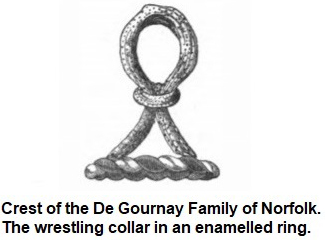
- The Belt Wrestling (wrastelynge by holdster). The “Belt” was usually also a rope or a stout leather belt girdled around the waist. It was also a Catch-Hold style, one hand to the belt and with another hand wrestlers usually would grasp the wrist or elbow of their opponent. In this style wrestlers would try to get into close quarters, and the cross-buttock would be the main way of throwing, they called it a hip-lift technique, tripping and hooking also were important in that style. In this style there was less kicking since it was not as productive as when you have your man at arms’ length.
- The Hug (hugg wrastelynge). In this style both men equally grabbed each other “above and under the shoulder” and from that hold (fixed hold wrestling) were supposed to give a fall. The only legit methods of throwing were: tugging, swaying and lifting. Neither use of legs or feet for throwing nor any other wrestling technique was allowed. The physical strength was a decisive factor for winning those contests.
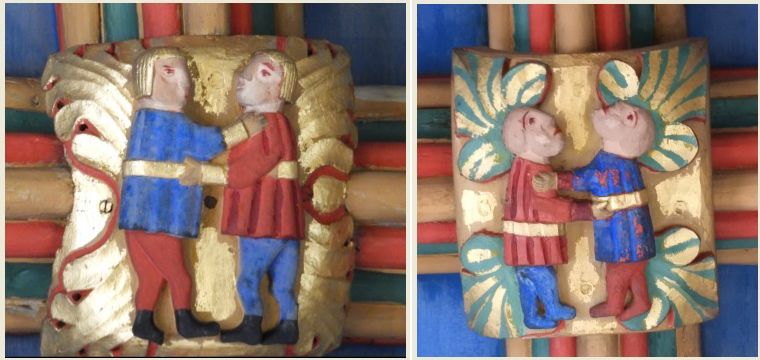
St Mary's Church, Beverly, East Riding of Yorkshire (England)
Roof Bosses Wood Carving: Two Men Involved in a Girdle-Wrestling Match, 1500s
NOTE. The basic rules of the girdle-wrestling style featured on these roof bosses were: catch-hold, one hand to the belt, another hand anywhere above the waist.
Hooking legs and tripping feet allowed. Shifting, adjusting and breaking initial holds allowed. A throw (first down above the feet to lose) must be given from the "one hand to the belt" hold.
All three traditional English styles of wrestling (“collar”, “belt” and “hug”) were of Norse/Viking or Scandinavian (North Germanic) heritage. It was Danes and Normans who brought their folk wrestling to England in the VIII-XI centuries. Grabbing “tools” with both hands was allowed. In English folk and pro wrestling matches the noble art of tripping was the number one skill.
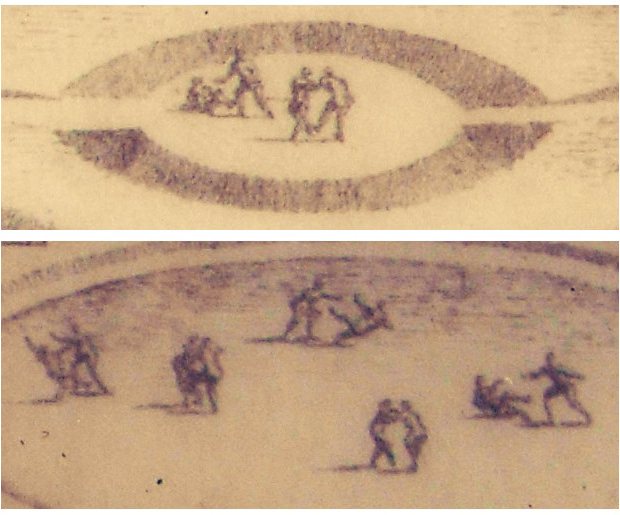
"Wrestling at Arms Length near Penrith"
King Arthur's Round Table, Eamont Bridge, Cumbria (England)
Engraving by Wm Stukeley, dated 1725-08-15

Medieval English Wrestling: The Hug.
Name: RECREATION, MS, Two medieval peasants wrestling during feast
Credit: Encyclopaedia Britannica Films thru The Getty Images
NOTE.
The Hug Wrestling demo made for this educational video precisely followed the original rules of that wrestling style, such as:
- there's no "locking hands" in the beginning of the bout, the "Full Hug" technique is an essential part of the struggle and can be achieved by drawing opponent towards the chest
- the allowed takedown techniques are tugging, swaying and lifting
- no use of legs and feet for throwing is allowed
Back falls governed wrestling contests very rare, since from a standing position (it was a Standing Wrestling) to achieve a back fall is pretty hard (depending on the definition of the back fall of course), and no one needed to waste time on further argumentation whether there was or wasn't a fall (AKA disputed falls). Back fall had different definitions (various combinations of shoulders, hips and heels) but perfect back fall was a complete flat horizontal position – perfectly aligned neck, shoulders, hips, buttocks, heels striking the ground at the same time. Though most of the wrestling matches were “three go downs” to lose meaning that it was enough to take opponent down on any part of his body (including knees, or hands), basically it was enough to cause any kind of fall by a simple take-down.
The styles similar to three English traditional styles of wrestling were practiced in the neighboring Wales:
- Cwdwm Braich – wrestling at arm's length
- Cwdwm Klos – close wrestling, throwing from the breeches’ waistband/belt hold.
- Cwdwm Cefn – throwing from the back hold.
Notably, similar wrestling styles were practiced in Ireland and were known under the names of:
- “Collar and Elbow” Wrestling,
- Girdle (or belt of leather) Wrestling (mentioned in the “Love Songs of Connacht” by Douglas Hyde, 1893 edition, Pages 49-51),
- “Shoulder and Hip” Wrestling (“Barrog” or Close Hug Wrestling);
as well as in Scotland where they were known under the names of:
- “Long Grip”, a jacket style, in which wrestlers take equal square holds (one hand to the collar, the other hand on the side right under the arm) and wrestle at the Arms Length,
- “Breek-bandit” (Belt Wrestling),
- “Short Grip”, equal above and under cross-wise hold around the body, Hug Wrestling.
The information about 3 traditional Scottish styles of wrestling was discovered and kindly presented to me by my dear friend wrestling historian from Ireland Mr. Stephen Curtin of Charleville, County Cork.
As previously mentioned any holds below the waist were strictly prohibited, yet the Catch-Holds of the legs and feet were known in English folk wrestling, but solely, and only as a reaction on the unfair kicking, i.e. kicking of the knee or kicking above the knee. The great depictions of these kind of holds are present in the form of Medieval misericords’ wood carvings such as those in the Abbey of St Mary the Virgin, Tewkesbury, Gloucestershire (14th century) and in St George’s Chapel, Windsor Castle (15th century).
 Misericords:
Misericords:
Left: Abbey of St. Mary the Virgin, Tewkesbury, Gloucestershire (14th Century)
Right: St. George's Chapel, Windsor Caste (15th Century)
Description: Wrestling at Arms' Length (Collar Wrestling), Kicking, Leg HoldThe pro wrestlers of that era were entertaining crowds during the religious or folk festivals which were held downtown, usually on an erected wooden stage, or they would go and perform on the special occasions at the castles which belonged to the local nobility. It was a paid job. In England unlike in many other European countries the profession of wrestling entertainer was well established during the Middle Ages. Usually it was a travelling troupe of performers (just like acrobats, or artists) with a “manager” (veteran pro wrestler) who was trying to book his men making sure that they always have a job. The wrestlers just like other professionals (craftsmen) of that era had their own guilds (unions).
Another brilliant find made by historian Stephen Curtin was a XVII century Catch-Hold Wrestling reference (see the text below) which appeared in the book by Joannes Maria de Franchis called "Of the most auspicatious marriage: betwixt, the high and mightie Prince, Frederick; Count Palatine of Rheine, chiefe sewer to the sacred Roman Empire, Prince Elector, and Duke of Bauaria, &. and the most illustrious Princesse, the Ladie Elizabeth her Grace, sole daughter to the high and mightie Iames, King of great Brittaine, &c. In III. Bookes.” The original language of the book was Latin; the English edition was printed in 1613.
"Next this Palestrian wrastlers in the field, Their bodies suppled by Ceromatists: To try by force, to force each other yeeld, VVith naked armes and brests approach the lists, VVhere the behoulders all admire to see, How ably agile these Luctators be. At first encounter, cunningly they set Their stable nimble feet, next with their hands This seekes, that striues, how surest hold to get, That he may spoyle his Aduerse as he stands: Where arme with arm, and foot with foot combining, They trip, preuent, chip, fall with inturns twyning."
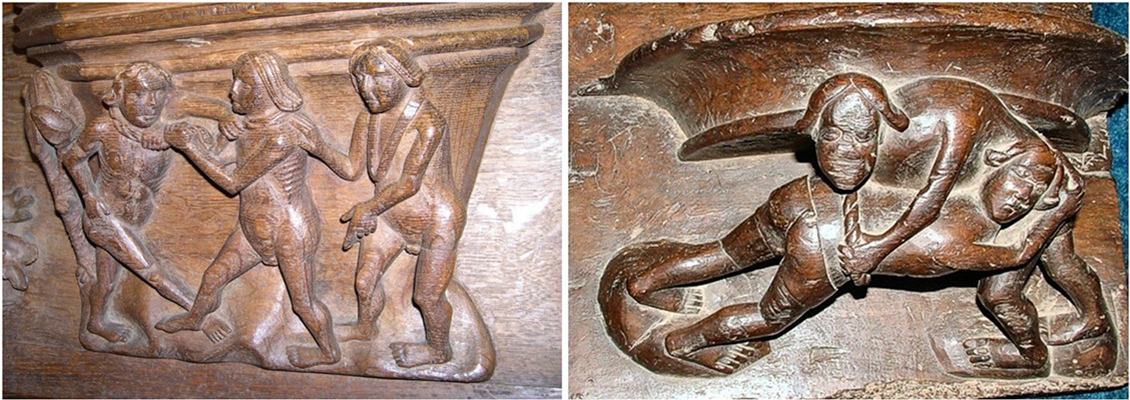 Misericords:
Misericords:
Left: Bristol Cathedral of the Holy and Undivided Trinity
Collar Wrestling (16th Century)
Right: The Priory Church of St Peter, Thurgarton, Nottinghamshire
Belt Wrestling (15th century)Nottinghamshire's Sir Thomas Parkyns (1662-1741), who was known as the “Wrestling Baronet”, of Bunny, and master of self-defense Zachary Wylde, of Yorkshire, both promoted Catch-Hold wrestling in the early 1700s. Parkyns "taketh what he pleaseth of him" and Wylde suggests to "take hold wherever he pleases" even including the dangerous full-Nelson hold. In both cases only holds taken above the waist were considered fair.
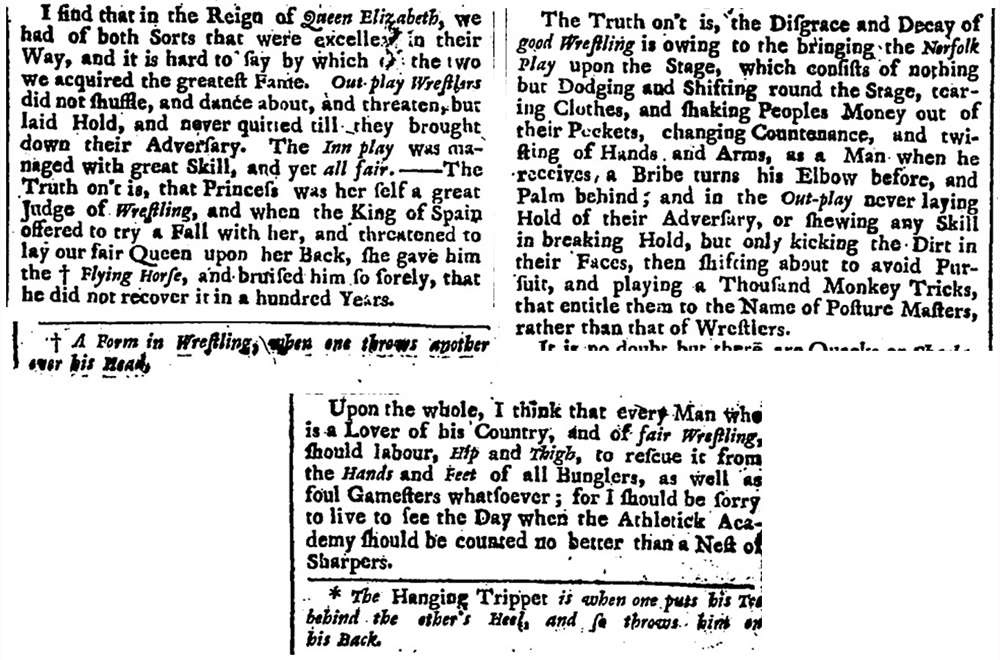 Farley's Exeter Journal, 1726-1728
Farley's Exeter Journal, 1726-1728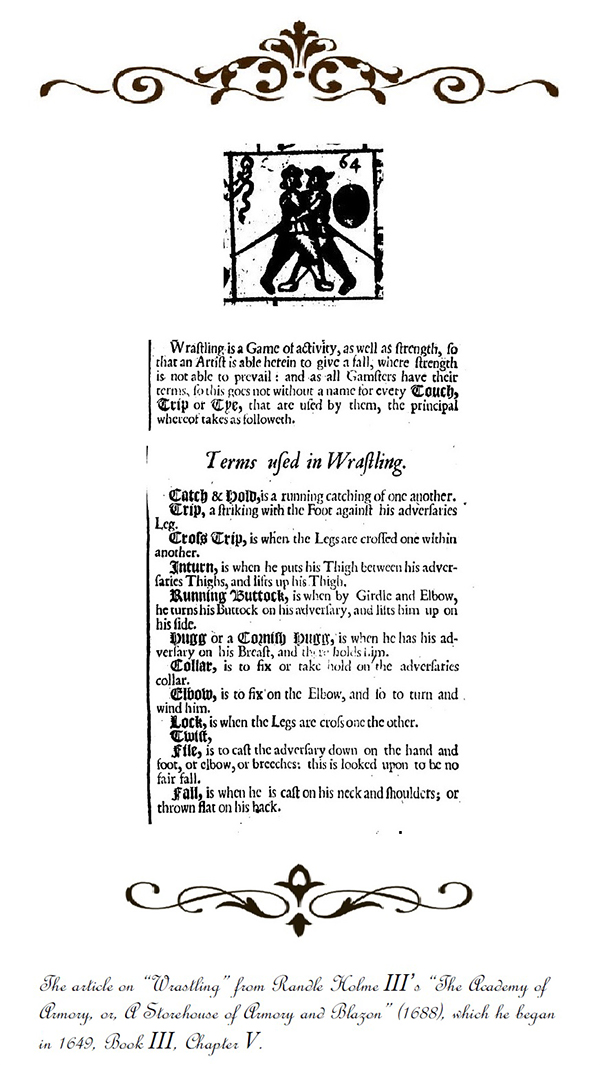 Parkyns became famous all around the country as an author of wrestling manuals. These include, “Inn Play or Cornish Hugg Wrestler” as well as a set of “General Rules of English Wrestling,” the fullest edition of which was published in 1727. His wrestling style was the Catch-Hold, in which an initial hold doesn't exist; neither does any applied hold need to be maintained during the match. The holds were not applied on any sort of garments (as in Cornish/Devon or Norfolk) but instead were applied directly to the parts of the person’s body above the waist (such as head, neck, arms, and torso). Use of the legs and feet for throwing in that style just like in any other traditional English wrestling game played a significant role.
The fall was counted when any two joints (such joints of human body as, hips, shoulders, elbows, wrists, knees, and ankles.) simultaneously hit the ground, and three foils (if either of two wrestlers fell upon any part of the body) were a substitute for one fall. All of the matches were three out of five falls. The wrestlers would wear a waistcoat and shirt.
In his writings Parkyns defines the undisputable or fair back fall according to the old English tradition as: “the Head and Shoulders coming to the Ground first”. These kinds of falls happen when a wrestler is lifted off his feet and thrown a “complete somersault” (heels over head) and falls head foremost.
The definition of “two joints” for the fair back fall (flat on his back) differed from place to place. Generally it stood for the combination of shoulder and hip (or heel) on the opposite side.
CORNISH WRESTLING RULES
"The mode of wrestling in Cornwall is very different from that of Devonshire, the former is famous in the hug, the latter in kicking shins. No kicks are allowed in Cornwall, unless the players who are in the ring mutually agree to it. A hat is thrown in as a challenge, which being accepted by another, the combatants strip and put on a coarse loose kind of jacket, of which they take hold, and of nothing else: the play then commences. To constitute a fair fall, both shoulders must touch the ground, at, or nearly, the same moment. To guard against foul play, to decide on the falls, and manage the affairs of the day, four or six sticklers (as the umpires are called) are chosen, to whom all these matters are left."
(Sam Sam's Son, July 20th 1826)
FAMOUS CANN v POLKINHORNE MATCH
"At half past twelve the champions entered the ring, and were loudly cheered by the numerous company. A striking difference was perceived between the two men when they stripped; Polkinhorne being nearly twice as stout as Cann, and 3st. 4lb. heavier. Cann weighs 12st. 71b. They were, however, nearly of a height; and, if there was any advantage in tallness, it was on the side of Cann. Polkinhorne played without shoes; but, as kicking forms part of the tactics of a Devonshire wrestler, Cann had a sboe on the right foot. The terms of the wrestle were, that the wager should be decided by the best of three back falls, to be determined by four tryers-two Devonshire and two Cornish: the men to catch what hold they could. Betting was considerably in favor of Cann before the set-to."
(Pierce Egan's Anecdotes (original and Sselected) of the Turf, the Chase, the Ring, and the Stage, 1827 article "Wrestling, Devonport, October 23rd, 1826")
NOTE: From the paragraph above it appears that originally in Cornish wrestling it was a 2 shoulder touch-fall that was counted as a fair back fall contrary to the well known 3 and 4 point back falls which became a standard in the second half of 19c. Another important detail is that it looks like often not only the jackets holds were allowed but but rather holds of any part of the body above the waist.
Parkyns was the founder of the first annually held professional wrestling championship tournament in Bunny, Nottinghamshire. This championship existed for many years after his death and the last such tourney was held in 1809. Also it was Parkyns who in the 1700s established a basic pro wrestling promotion. At his place, he had several men whom he employed for the purpose of doing wrestling exhibitions (matches) for his friends and himself for entertainment.
According to the above-mentioned Parkyns the two most popular styles of wrestling in England were Norfolk “Out-Play” and Bedfordshire “In-Play”. As it was previously mentioned, historically, the core skill of traditional English wrestling styles was in using the legs and feet for throwing opponents to the ground; these wrestling techniques were known as “hooking” and “tripping” respectively. Hence likely the names of the two folkstyles were also based on that particular wrestling strategy, namely:
- The Norfolk “Out-Play”, or wrestling at Arms Length, in which attacks on the legs/feet of opponent come mostly from the “outside” of the natural fork of human body;
- The Bedfordshire “In-Play”, or Close Struggle, in which attacks on the opponent’s legs/feet mostly come from the “inside”, by placing legs/feet in between the legs/feet of the adversary.
For centuries there were always two champions of England those of the West and of the North. One of the famous attempts to get both champions in the ring happened during 1817. About three miles from Pinner in London, West and North finally clashed for the Championship of England. The match was for 10 guineas (gold coin worth 21 shillings) a-side. A Somersetshire man named Sam Harber wrestled Isaac Nicholson of Thirsk (North Yorkshire). Both men weighed 13 stones (126 pounds). It was a dramatic struggle that lasted twelve minutes. Westerner won by giving his opponent a “sweeping cross-buttock.” The news reports weren't specific regarding the style used in that particular contest. But it’s obvious that it was Catch-Hold since it was a one fall match and Catch-Hold was the only existing compromised style. As it was said before, back then wrestlers usually competed only in their own style and there was no competitions open to the representatives of both styles. Often Catch-Hold was called as the “wrestling according to the London Prize Ring Rules”, which was a standing Catch-Hold of the body above the waist, tripping and hooking legs allowed, back fall decided the victor, sometimes three foils substituted one back fall. This style was easy to learn and it didn't require any “specific knowledge”, unlike the Cumberland Back-Hold (fixed hold style) or Cornish/Devon style (jacket holds only). In 1851, there was an attempt to make a “match of the century” between the two best wrestlers of their time in England. The Cumberland and Westmorland Back-hold Champion Robert Atkinson was supposed to wrestle against the Champion of Cornish/Devon Ring, Thomas Gundry. The conditions were supposed to be two falls in Back-Hold, two falls in Cornish/Devon, and the odd fall in Catch-as-Catch-Can (more likely according to the London Prize Ring Rules). Unfortunately this match never happened.
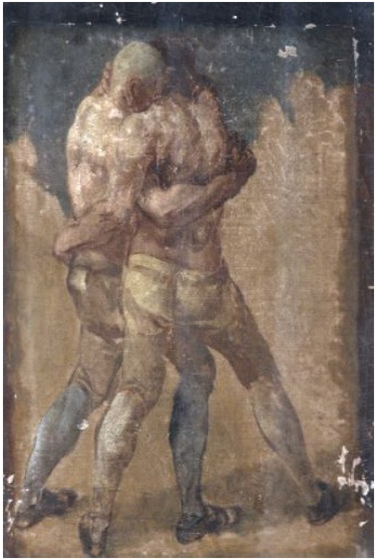 Painting: "The Wrestlers", manner of Fancis Hayman (1708-1776),
Painting: "The Wrestlers", manner of Fancis Hayman (1708-1776),
previously attributed to Thomas Gainsborough (1727-1788)In the early 1870s the “new style of wrestling” was introduced among the London amateurs, it was called the Catch-Hold. This style became extremely popular in metropolis especially after the brilliant performances of French pro wrestlers in England. Graeco-Roman style, which was advertised as the French national wrestling style impressed local sporting circles a lot. The English reply to that was the “invention” of Catch-Hold, which was designed to represent the English national wrestling traditions. That style was “invented” in London by famous bone setter Prof. J. Atkinson of 12A Park Lane in conjunction with Mr. Moses Rigg. In the early 1870s annual Catch-Hold amateur tournaments along with boxing (under the patronage of Marquess of Queensbury) and bicyclist championships were held at Lillie Bridge, London. The organizer of those championships was J.G. Chambers of Amateur Athletic Club (AAC) a London based amateur sports organization. First champion in 1871 was Walter Armstrong, the wrestler who in 1890 wrote the famous book on wrestling called “Wrestling (Styles and Systems).” Despite the Catch-Hold wrestling being a “new invention”, it has to be acknowledged that in fact this style of wrestling can be considered the most historical English wrestling style since it basically was the old folk English wrestling style known as the Peasants Wrestling.
Before the invention of Catch-Hold there was no such a thing as a unified English Pro Wrestling Championship. Instead there were championships of the West Country and North Country rings. During the Golden Era of Lancashire Catch-as-Catch-Can (1860s) the Lancashire Wrestling Ring was established as a third pro wrestling ring of England. Historically, it was acceptable to have multiple champions of England in different styles. In 1873 the greatest pro-wrestling gathering in English history took place., It was the Catch-Hold Easter Tournament which was held at Lillie Bridge, London. It was the first time in history of English wrestling representatives of all schools participated. Both Northern and Western men were pleased with the conditions of the “new” style. Westerners were happy that it was a Catch-Hold style. Northern men were pleased that the first down was to lose condition signified victory. Both parties were satisfied that tripping and hooking legs were allowed, but the leg holds and ground wrestling, the main features of Lancashire catch, were strictly prohibited. Northerners, represented by many great pro-wrestlers including their long time champion Richard Wright and a rising star champion, George Steadman, were expecting an easy victory (simply because they outweighed all West Country men), but it was a Lancashire man who became entitled to the honors of the first unified championship of the English Wrestling Ring. William Snape, AKA “Dipper”, a blacksmith from Bolton, Lancashire who was known as the “Lancashire Giant” (he was 6 foot 2 inches tall and weighed 18 stones) out wrestled them all. Organizers were trying to make that championship for professionals annual, but their initiative failed, no one wanted to compete against the “Lancashire Powerhouse” Snape, who soon retired from wrestling undefeated, never being able to find a worthy opponent for himself at either London Catch-Hold or at his native Lancashire Catch-as-catch-can.
The London Catch-Hold of the 1870s-80s was a standing Catch-as-Catch-Can in which only holds of the body above the waist were considered legal. Of course the essence of English wrestling, the use of feet (tripping) and legs (hooking) for throwing an opponent was allowed. The conditions of the matches were “first down (on any part of the body) to lose.” Regular matches were one fall affairs, and the final bout was two out of three falls. No kicking, hitting, or biting, or any other act of deliberate brutality was legal. Wrestlers had to appear in the ring wearing tight jerseys, drawers and socks. This wrestling style utilized the best of techniques which were for centuries part of various English folk wrestling modes, namely the tactics and skills in wrestling at Arms Length, at Closed Struggle and of course at the equal above and under hug (Back-Hold). The London Catch-Hold was widely promoted and the competitions for both amateurs and professionals were regularly held in the biggest cities all around the country.
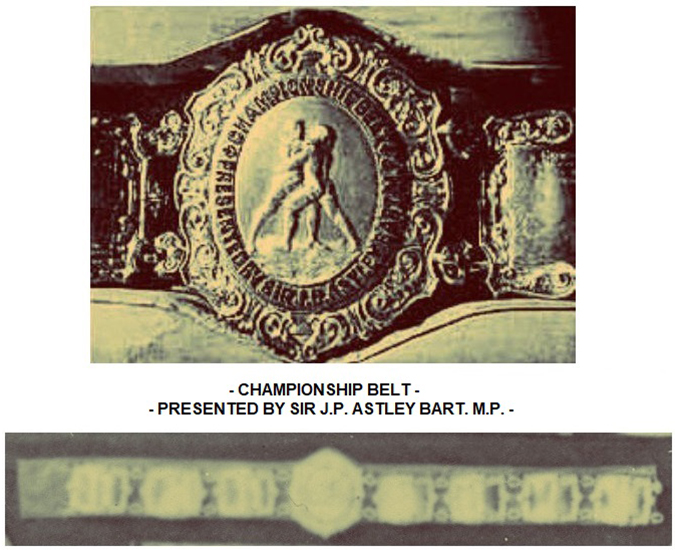 The London Catch-hold never found support of the managers and directors of competitions (“bosses”) who were running the pro-wrestling (Cornish/Devonshire, Cumberland/Westmorland and Lancashire styles) and the amateur wrestling (in case with Cumbrian Back-Hold) rings in the country. That is why in the mid 1870s popularity of Catch-Hold dropped and at the annual gatherings of Amateur Athletic Club of London at Lillie Bridge. It was even replaced with Loose Wrestling or Catch-as-Catch-Can (German Gymnastic Society version, AKA the German Ringen). In 1880, 1881 and 1882 under the patronage of Sir John Astley at Lillie Bridge was held the tournament called “The Astley Belt”.
That title will remain the most unique pro wrestling championship in English history and the most prominent gathering of English pro-wrestlers of all times, it was that title and that sterling silver belt (symbolic of the undisputed wrestling championship of England) which the most famous Back-Holder of all times George Steadman, of Drybeck, (winner of all three tourneys) cherished and was the most proud of winning. The London Catch-Hold ceased to exist by the 1900s, but it was still taught by the best pound for pound Catch-Hold wrestler of England, middleweight champion John Wannop, of Carlisle. Even in 1907 Wannop had "Catch-Hold Championships" at his own school in London.
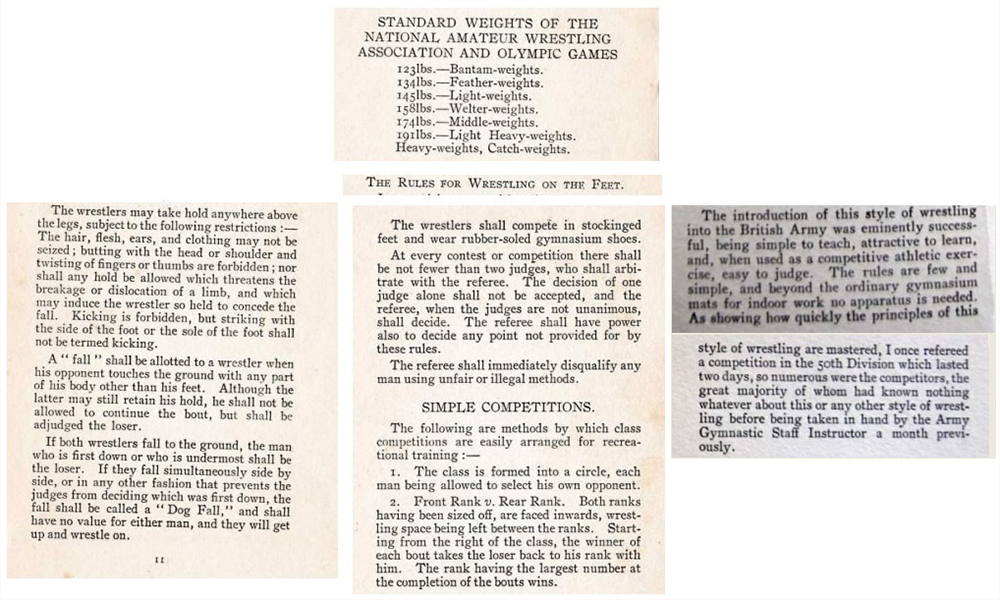 Excerpts from "The Art of Wrestling" (1919)
Excerpts from "The Art of Wrestling" (1919)
by British and Olympic champion wrestler George de Relwyskow
Courtesy of Cay Fabian of Germany and Robbie Burrows of England.In the late 1910s the British and Olympic champion wrestler George de Relwyskow (1887-1942) revived the ancient English Catch Hold. When he was a Royal Army Physical Training Corps instructor at Aldershot (Hampshire, England) he introduced Catch Hold (standing style, holds above the waist only, tripping allowed) in the Army system of wrestling, a system he created.
Ruslan C Pashayev is an expert-member of the Traditional Sports Team of the Instytut Rozwoju
Sportu i Edukacji
(the Institute of Sport Development and Education), Warsaw, Poland.
© 2020 Ruslan C Pashayev All Rights Reserved.
|
